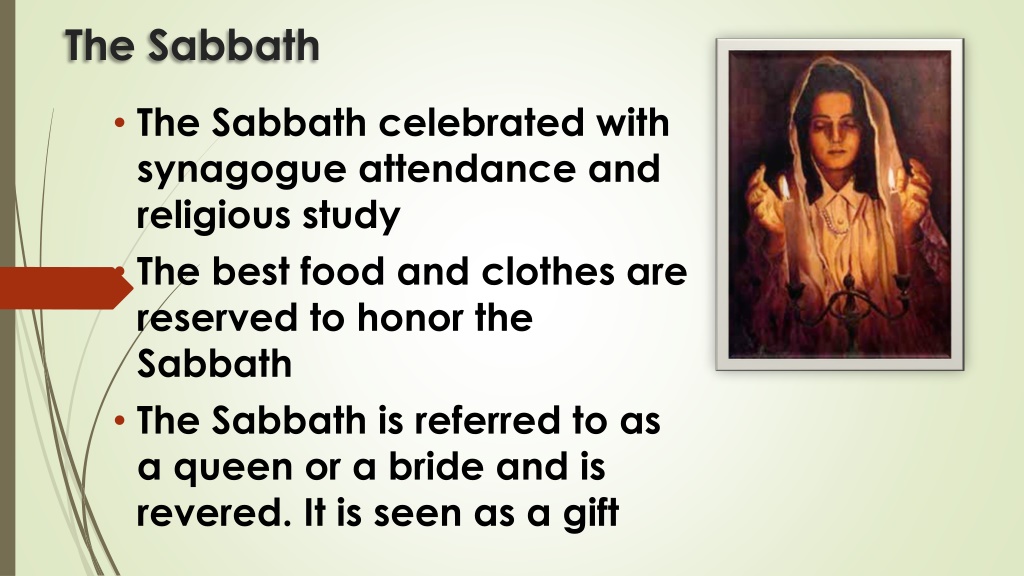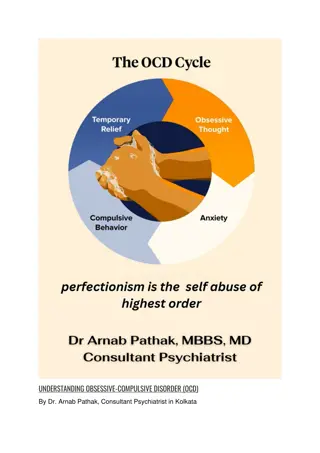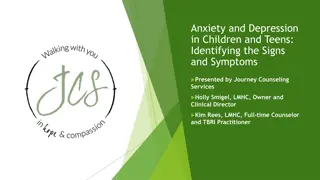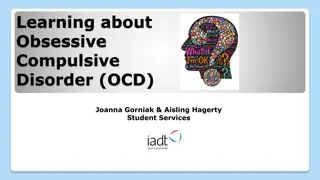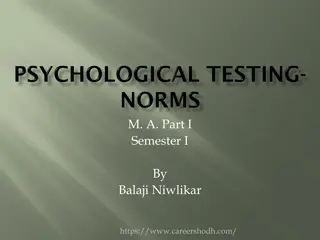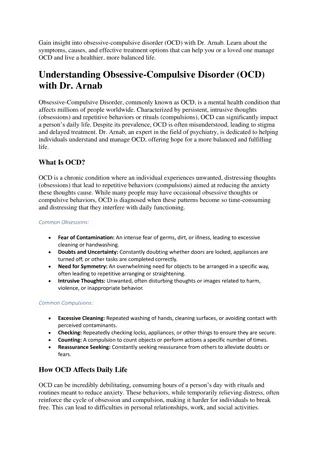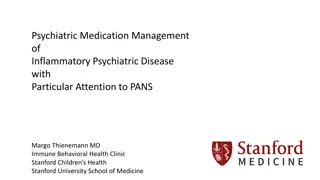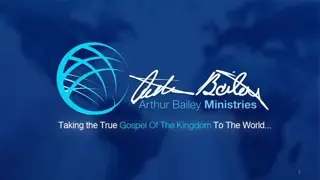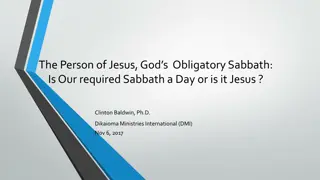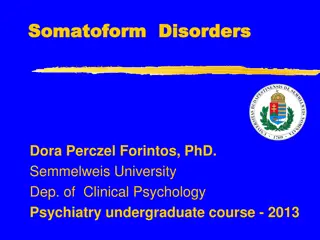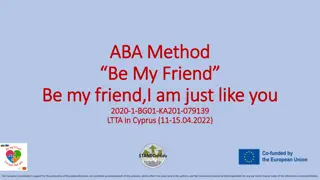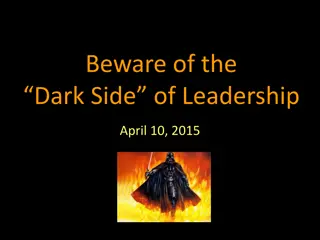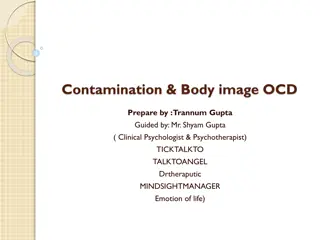Understanding the Sabbath and Obsessive-Compulsive Disorder (OCD) Tendencies
The Sabbath is a sacred time for rest and reflection, marked by communal rituals and gatherings. However, for some individuals, the strict adherence to rules and performance-based emphasis can trigger OCD tendencies, leading to challenges in balancing religious observance with mental well-being.
Download Presentation

Please find below an Image/Link to download the presentation.
The content on the website is provided AS IS for your information and personal use only. It may not be sold, licensed, or shared on other websites without obtaining consent from the author. Download presentation by click this link. If you encounter any issues during the download, it is possible that the publisher has removed the file from their server.
E N D
Presentation Transcript
The Sabbath The Sabbath celebrated with synagogue attendance and religious study The best food and clothes are reserved to honor the Sabbath The Sabbath is referred to as a queen or a bride and is revered. It is seen as a gift
The Sabbath The Sabbath is for contemplation and rest from daily concerns Families eat together Relationships are strengthened as extended families and friends come together
The Sabbath Facilitates a mindful attitude because it differs from the week It s rituals create meaning Communal prayer creates a sense of community Creates a rhythm to the week
Absence of customary coping devices: music, phone Little to distract from worrying thoughts Difficult for single people to find a place in the community Family conflict can intensify It often creates conflict with work THE SABBATH: Difficulties
Emphasis on strict adherence to rules Exhortation for exemplary traits (Midot) strive for perfection personal failings not tolerated Idealism is encouraged emulate idealized role models struggles with failure are not discussed Performance and behavior emphasized-obsessive religiosity Religious observance is valued over emotions, relationships, affection Obsessive- Compulsive Disorder
In both, rituals performed repetitively in a set order precisely without omission More of the OCD rituals related to Obsessive- Compulsive Disorder and Religion religion Tendency to turn to the rabbi for questions about religious OCD rituals Common OCD rituals: Prayer for men Ritual Immersion for women (Greenberg & Shefler, 2002)
Perfectionism praised: strain on the young Perfectionism and compulsion misinterpreted as extreme devotion OCD in adults not more than general population obsessions more related to religion or scrupulosity Obsessive- Compulsive Disorder (Schechter, 2012)
Jews in the U.S. less well-being; more depression 1992 NIMH study: No difference in psychiatric disorders Higher rates: depression and dysthymia Lower rates: alcohol abuse Orthodox: perception of support from religious leaders and God associated with lower levels of emotional distress (Lazar & Bzork, 2008) Higher levels of orthodox religious beliefs and practices correlated with lower levels of depression and anxiety (Rosmarin et al, 2009) POPULATION TRENDS
Less mood disorders compared to general population Community inclusion might buffer life events More anxiety disorders Intense community expectations Lack of emotional expressiveness and emotional vocabulary MENTAL HEALTH IN ONE CHASSIDIC COMMUNITY Schechter, 2012
No evidence for increased psychosocial stressors or psychiatric disorders in larger families Mental Health and Family Size
Options for approaching religion in therapy: 1. Acknowledge religious issues but focus exclusively on psychological TREATMENT CONSIDERATIONS dimensions 2. Directly address religious concerns 3. Invite client to reflect on religious beliefs
Air of curiosity: inquire into client s religious view and practices that may impact the therapy Are there beliefs or attitudes or teachings from your religious tradition that might lead to an alternative viewpoint? TREATMENT CONSIDERATIONS
Therapist can directly prescribe religious practices such as: Meditative contemplation or prayer Social engagement through the religious community Being mindful of Torah TREATMENT CONSIDERATIONS teachings Discussion with a religious figure to explore philosophical challenges to negative self- statements
Social engagement such as participation in a religious study TREATMENT CONSIDERATIONS group Volunteering and charitable giving to promote well- being
PARABLES Metaphor, parables, and fables (Mashal and Agadah) A tradition of fables and parables (Midrash) in the Talmud and among medieval commentators for teaching ethical and legal doctrine Leads to cultural familiarity Jewish storytelling- psychological concepts presented within a familiar value system
Teaching through the use of parables is a non- threatening way to introduce a new concept Allows the therapist to communicate indirectly by imparting a moral (Caspi & Greene, 2011) PARABLES
Hassidic Tales Used by rabbis to counsel followers about everyday problems
Metaphors Stories, Tales, Anecdotes, Jokes
Symbolic form of communication Can be used therapeutically Metaphoric stories: a traditional means of teaching values Can convey therapeutic values: rational thinking, empathy for oneself, marital communication Metaphors
As soon as you hear, Once upon a Time Transported into a semi- hypnotic state Opens up the mind More receptive to incoming messages Focuses attention Bypasses resistance Stories are Hypnotic
Different perceptions of problems Allow different outcomes Relax defenses Simplify the message Highlight key aspects Foster greater understanding Stays in memory Promotes Problem Solving
Allow the client to cognitively reorganize life schemata Facilitates understanding of connections: maladaptive behaviors and interpersonal outcomes and emotions Becomes a code between therapist and client Therapeutic Parables
Aaron Beck A Metaphor straddles domains providing a conceptual bridge to a new perspective that can cast one s experience in a new light. It can deliver succinct implicit messages to convey abstract principles. Beck, , 2010
Juxtaposes ideas to form new connections Evokes sensory imagery Activates meaning at a subliminal level Reframes through implication Milton Erikson
Highlights key features Makes abstract ideas comprehensible Elaborate, abstract ideas become succinct The concept becomes vivid and visual. The Magic of Metaphors
Humor Humor is a large part of Jewish cultural tradition Humor can be seen in rabbinic and medieval commentary Dates back to the bible. When the Jews left Egypt with the Egyptians in hot pursuit, the children of Israel lifted their eyes heavenwards and cried, Were there no graves in Egypt, that you brought us to die here in the wilderness? (Exodus 14:10-11)
This sharp and ironic statement was made at a time of the deepest anxiety and despair. This marks the sense of wit that is a characteristic trait of the clearheaded Jewish Rabbi Samson Raphael Hirsh people The beginning of a beautiful friendship between existential threat and humor in the Jewish people
Jews became known for humor at the beginning of the Enlightenment Becomes prominent during periods of crisis when Jews seek relief from pressure History of Jewish Humor Hillel Halkin
Humor has been a defense against living in foreign lands, often under persecution A way that a powerless people, living under hostile governments could couch seditious sentiments Ruth Wisse
Jewish Comedians In 1978, Time magazine claimed that 80% of all US comedians were Jewish
The Marx Brothers Jack Benny Carl Reiner Mel Brooks Don Rickles The Three Stooges Milton Berle Neil Simon Henny Youngman Buddy Hackett Jerry Seinfeld Sarah Silverman Billy Crystal Gilda Radner Goldie Hawn Andy Samberg George Burns Sid Ceasar Woody Allen Jackie Mason Rodney Dangerfield Adam Sandler Judd Apatow Gene Wilder Andy Kaufman Chelsea Handler Bette Midler Andy Larry David Ben Stiller Jon Stewart Seth Rogan Sacha Baron Cohen Roseanne Barr
To suggest a therapeutic lesson or value without pontificating An indirect way of making a point Concentrates the attention Doesn t generate defensiveness and rejection In a way that the receiver will likely remember The Role of Humor in Psychotherapy
Enables direct confrontation of challenges by maintaining a positive outlook in the face of adversity Can facilitate resilience by shifting perspective, distancing from problems, creating a social bond, increasing positive emotion, and relieving tension Can lead to reappraisal of stressors Humor
A form of metaphoric language Uses double meaning to peak and then disrupt our expectation Leaves the client cognitively off- balance Can help the client to separate from preoccupations to achieve greater cognitive flexibility Jokes
Any intervention that promotes health and wellness by stimulating a playful discovery, expression or appreciation of the absurdity or incongruity of life s The Association for Applied and Therapeutic Humor situations
Humor arises when our intellect is surprisingly frustrated and then importantly amended by a new observation of the world Schopenhauer
A creative process that allows a person to mentally hold two seemingly incompatible ideas at once; their complex and ambivalent perception, allows for more comprehensive outlook on things. Arthur Koestler
A long history of using parables to teach Jewish values in the Talmud and rabbinic literature, and of humor in Jewish life, provide culturally familiar vehicles for communicating therapeutic values, challenging and shifting perspectives, introducing creativity into the consulting room, and helping Orthodox Jewish clients move towards positive change. Metaphor and Humor in Therapy
